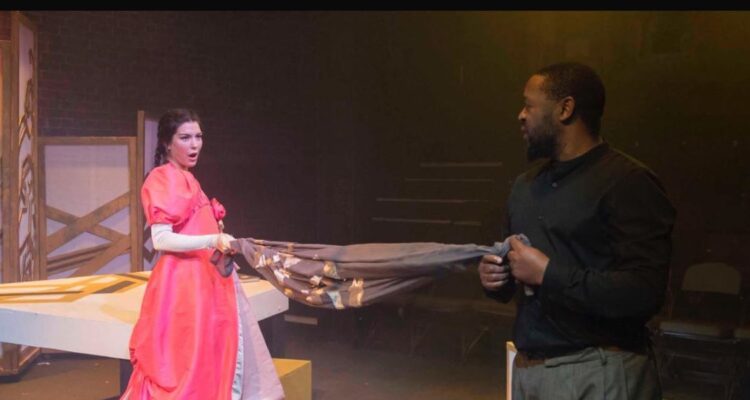Barefoot Opera make it their priority to update classics in an accessible way while using all available theatrical means to do so. This approach has paid off handsomely in their current production of La Traviata, which I was able to see in a short run as part of Grimeborn. I approach new productions of this over-familiar opera with a degree of wariness, but I should not have worried. From the opening of the prelude, with the fragile, wan main theme played on the accordion (a real inspiration!) it was one intriguing revelation and alteration after another, all of which made you think anew about this familiar work.
Key to success at Grimeborn is the right scale of adaptation – too small-scale and you don’t do justice to the layers of the original opera; but too large and you risk overwhelming the audience even in the larger space of Studio 1. What impresses about Laurence Panter’s arrangement for piano, accordion, clarinet and double bass was that the key lines of the music were always in place together with an appropriate range of timbres to underscore the shifting moods of the vocal numbers. In particular the accordion was a wonderful choice to register the sadness and sickness of Violetta while also offering a slightly sleazy jauntiness for the recurrent party scenes.
Equally impressive were the sets, costumes and choreography. When you see two reversible screens and a raised platform, you might think you are at the start of Madama Butterfly rather than La Traviata. But these turned out to be highly flexible abstract devices to indicate the homes of Flora and Violetta while leaving plenty of space on the stage for effective, if stylised, movement by the ensemble, whether in the jollity of the parties or in moments of dramatic confrontation. Reversible costumes and inventive lighting contrasts completed a most impressive contribution from the directors and supporting creative team.
A production of this opera stands or falls on the contribution of the three lead roles and here, again, we were well served. Beren Fidan was outstanding as Violetta, whether in her vocal command or in the fine-grained way in which she registered the contradictory emotions generated by the intolerable position in which the character is placed. From her acting during the prelude, which framed the action as a series of recolletions from her diary, through to her eloquently expressive death scene she engaged our empathy through the credibility and strength of her performance. In this respect she was equally well match by Tylor Lamani as Alfredo, who sang with taste and delicacy in Act One, before finding the ruthlessness and red mist needed in the middle sections, and remorse at the last.
Perhaps the most difficult role to bring off is Germont senior, but Mike Dewis did a good job in making the character more sympathetic than usual, despite some vocal challenges. The supporting work from Owain GwynFryn, Phoebe Rayner, Kezia Robson, and George Seymour was outstanding, with each of them providing vigorous characterisation to a range of minor roles and well-balanced ensemble singing.
One minor cavil: there was no programme beyond a QR code, and while this may be the way of the future, many of the audience, who were elderly, lacked any means of identifying the uniformly excellent cast. Surely a simple flyer could be provided, not least to relieve pressure on questions at the box office.
However, all-in-all this was Grimeborn at its best – capturing the essence of a universal masterpiece, yet finding new things to say that will reinforce its continuing relevance to modern audiences.
Composer: Giuseppe Verdi
Libretto: Francesco Maria Piave
Directors: Michael Spenceley & Alfie Chesney
Music Director and Arranger: Laurence Panter
Cast: Mike Dewis, Beren Fidan, Owain GwynFryn, Tylor Lamani, Phoebe Rayner, Kezia Robson, George Seymour
Until 28 September 2024
140 minutes, with interval
Photo Credit: Nigel Martin

